Active rest involves intentional, structured breaks that combine light movement or mindfulness to boost your creativity and mental clarity. By stepping away from work for activities like stretching, walking, or mindful breathing, you improve brain function and stimulate new ideas. These breaks help you reset focus and reduce fatigue, enhancing your problem-solving skills. If you’re curious about how to incorporate active rest into your routine, there’s more to explore for lasting benefits.
Key Takeaways
- Active rest involves gentle movement or mindfulness practices that enhance mental clarity and stimulate creative thinking.
- Incorporating outdoor walks or light stretching during breaks boosts neural activity and sparks new ideas.
- Regular, scheduled active rest routines improve focus, reduce fatigue, and foster innovative problem-solving.
- Movement during breaks increases blood flow and neural connectivity, supporting cognitive flexibility and artistic expression.
- Mindful activities like stretching or meditation help clear mental clutter, inspiring fresh perspectives for creative projects.
Understanding the Power of Active Rest
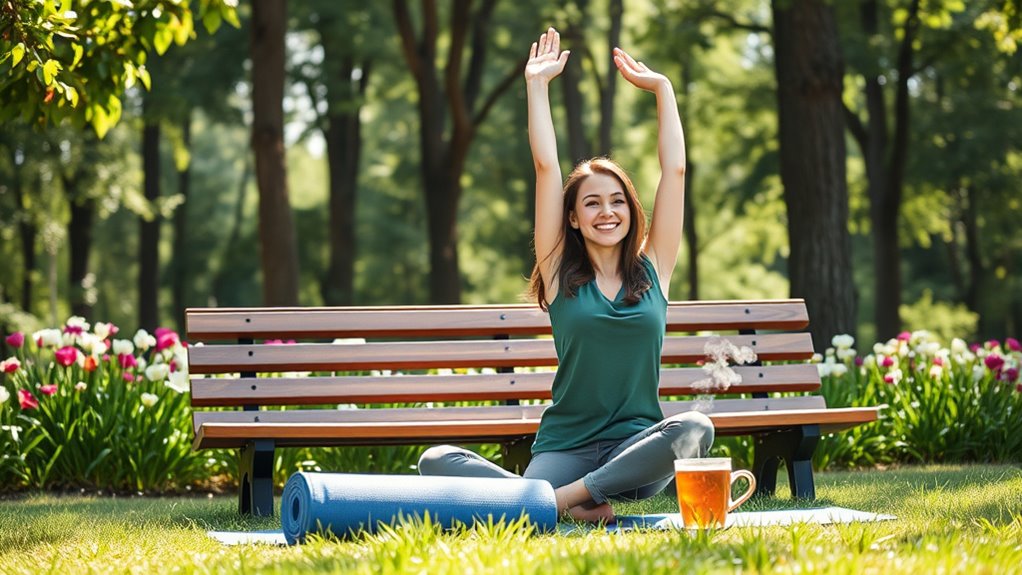
Active rest is a powerful way to enhance your recovery and boost overall fitness. When you incorporate mindfulness practices into your active rest routines, you promote mental clarity and reduce stress, which supports physical recovery. Gentle activities like walking, yoga, or stretching help improve your sleep quality by calming your nervous system and promoting relaxation. Better sleep, in turn, accelerates muscle repair and replenishes energy, making you more prepared for your next workout. Unlike passive breaks, active rest keeps your body moving without overexerting it, fostering a balanced approach to recovery. Additionally, understanding the importance of local resources can help you find suitable activities or professional guidance to optimize your rest and recovery routines. By intentionally engaging in mindful movement and prioritizing quality sleep, you optimize your body’s ability to heal, adapt, and perform at its best over time.
Differentiating Active Rest From Passive Breaks
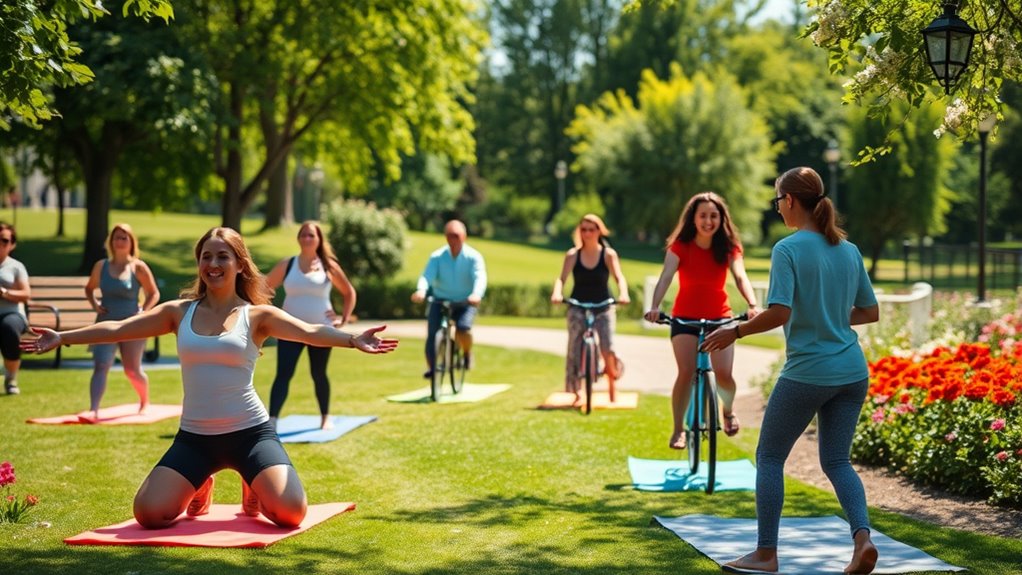
While both active rest and passive breaks allow your body to recover, they serve different purposes and involve distinct approaches. Active rest involves engaging in light movement or mindful activities like mindfulness meditation, keeping your body active without overexertion. Passive breaks, on the other hand, focus on passive leisure, such as lounging or watching TV, where you’re not physically engaged. To differentiate:
Active rest energizes the body with gentle movement, while passive breaks promote relaxation through minimal activity.
- Active rest promotes blood flow and mental clarity through gentle activity.
- Passive breaks emphasize relaxation and mental rest, often with minimal movement.
- Mindfulness meditation during active rest sharpens focus and reduces stress.
- Passive leisure may lead to mental disengagement but can offer temporary relief.
- Incorporating gentle movement like stretching or light walking during active rest can further enhance its benefits.
Understanding these differences helps you choose the right break to boost creativity and prevent burnout.
The Science Behind Movement and Creativity
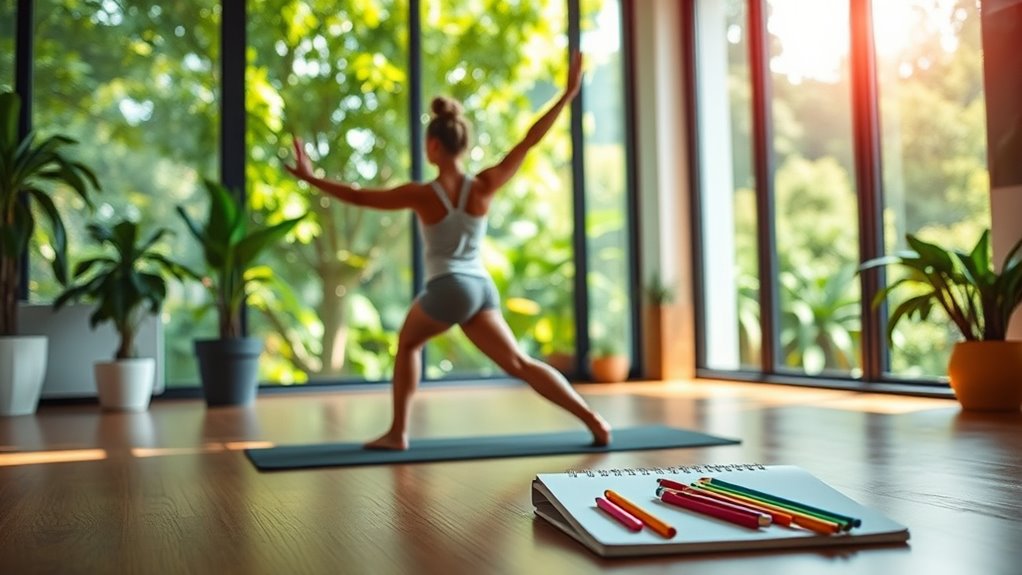
When you move, your brain works better and sparks new ideas. Physical activity boosts your focus and helps you think more creatively. Exercise isn’t just good for your body—it refreshes your mind too. Incorporating movement into breaks can significantly enhance your overall productivity and mental clarity.
Movement Enhances Brain Function
Research shows that movement directly boosts brain function by increasing blood flow and stimulating neural activity. When you move, you enhance the formation of neural pathways, making communication between brain regions more efficient. This process improves cognitive flexibility, allowing you to adapt and generate creative ideas more easily. To deepen your understanding, consider these points:
- Movement increases oxygen delivery to the brain, fueling neural processes.
- It promotes the growth of new neural pathways, strengthening mental connections.
- Exercise enhances neuroplasticity, helping you adapt to new challenges.
- Regular movement sharpens your focus, enabling better problem-solving.
- Engaging in physical activity at beach towns can provide a refreshing environment that further stimulates creativity and mental clarity.
Physical Activity Sparks Ideas
Engaging in physical activity can directly ignite your creative thinking by stimulating your brain in unique ways. Simple stretching routines get blood flowing, releasing tension that blocks ideas and encouraging fresh perspectives. Outdoor activities, like walking or cycling, boost your mood and spark new insights as your mind wanders freely. Movement increases neural connectivity, helping you connect unrelated concepts and generate innovative solutions. When you step away from sedentary tasks to move, you activate different parts of your brain, making space for creative breakthroughs. For example, electric dirt bikes can be a fun way to combine movement with outdoor adventure, further enhancing your creative flow. Whether it’s a quick stretch or a brisk walk outside, physical activity creates an environment where your ideas can flourish. So, don’t underestimate the power of movement to jump-start your creativity and inspire new ways of thinking.
Restored Focus Through Exercise
Physical activity doesn’t just spark new ideas; it also restores your focus, sharpening your ability to concentrate on complex tasks. Movement increases blood flow to the brain, enhancing cognitive function and attention span. Incorporating mindfulness meditation during breaks can further boost mental clarity. Exercise also promotes sleep optimization, leading to better rest and improved focus during work hours. To maximize these benefits:
- Engage in brisk walks or stretching sessions.
- Practice quick mindfulness meditation to reset your mind.
- Prioritize regular physical activity for better sleep quality.
- Use movement to break up long periods of intense concentration noise reduction technology.
Practical Ways to Incorporate Active Rest Into Your Day
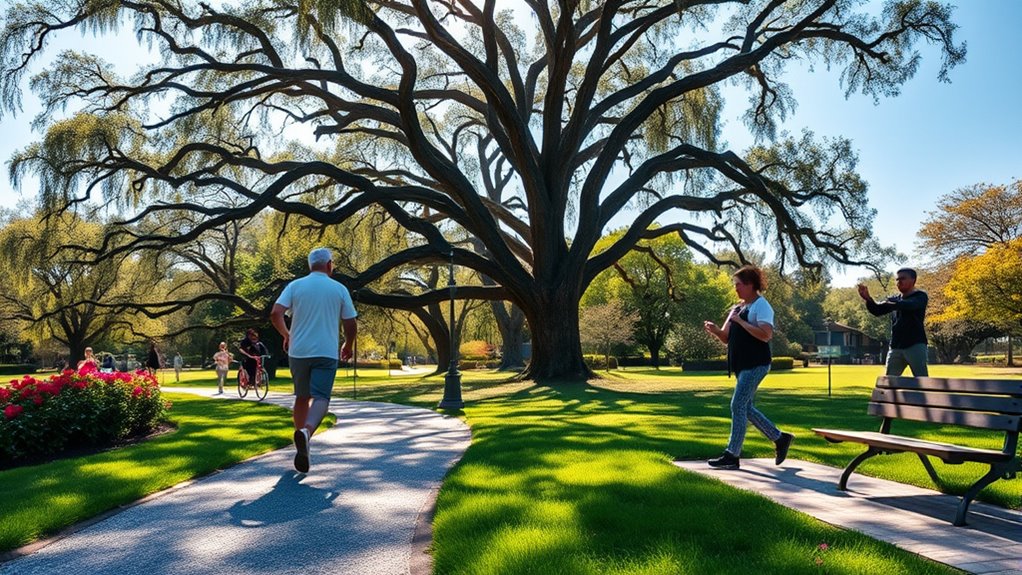
Incorporating active rest into your day doesn’t require major overhauls or dedicated workout sessions. You can easily integrate mindful stretching during short breaks to release tension and reset your focus. Stand up, stretch your arms, neck, and legs slowly, paying attention to how your body feels. Outdoor walks are another simple yet effective option; even a quick 10-minute stroll outside can clear your mind and boost creativity. Schedule these activities between tasks or during lunch breaks to make them a regular habit. Keep your movements intentional and relaxed, avoiding strenuous activity. These small, mindful pauses help you recharge, prevent fatigue, and maintain mental clarity throughout your workday. Consistent use of active rest techniques makes a noticeable difference in your overall productivity and well-being. Nike Tech innovations in sneaker design also encourage active lifestyles, making movement more comfortable and stylish during breaks.
Benefits of Structured Breaks for Mental Clarity and Innovation
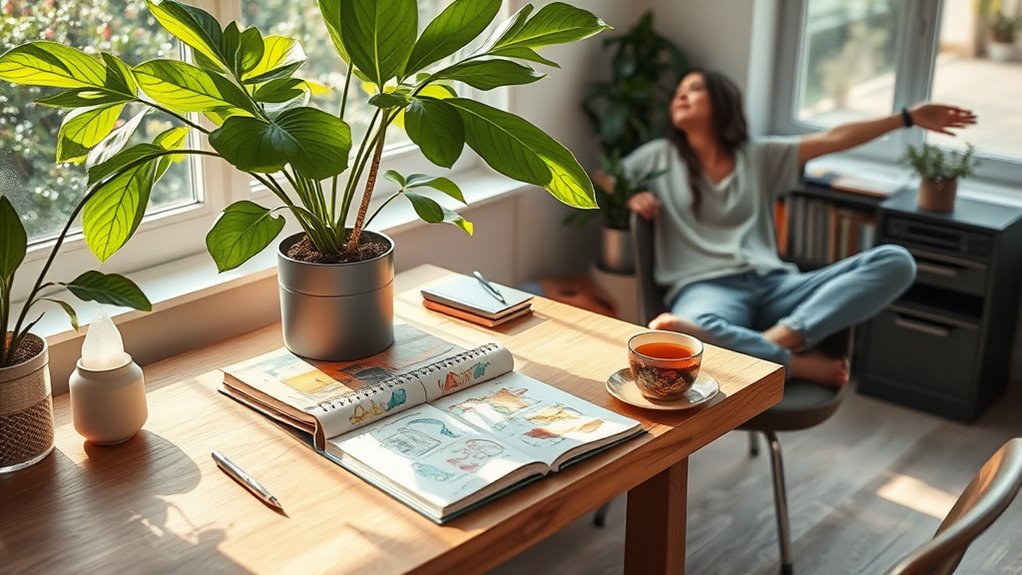
Scheduling structured breaks into your day can substantially boost mental clarity and spark innovative thinking. During these breaks, practices like mindfulness meditation help clear your mind, reducing stress and increasing focus. Creative visualization allows you to mentally rehearse ideas, enhancing problem-solving skills. Incorporating mindfulness practices into your routine can further support emotional resilience and overall well-being. Here are four key benefits:
Structured breaks boost mental clarity, reduce stress, and foster innovation through mindfulness and visualization techniques.
- Improved concentration and decision-making
- Enhanced ability to generate fresh ideas
- Increased mental resilience through relaxation
- Better integration of creative visualization to foster innovation
Success Stories: How Active Rest Transformed Creative Projects
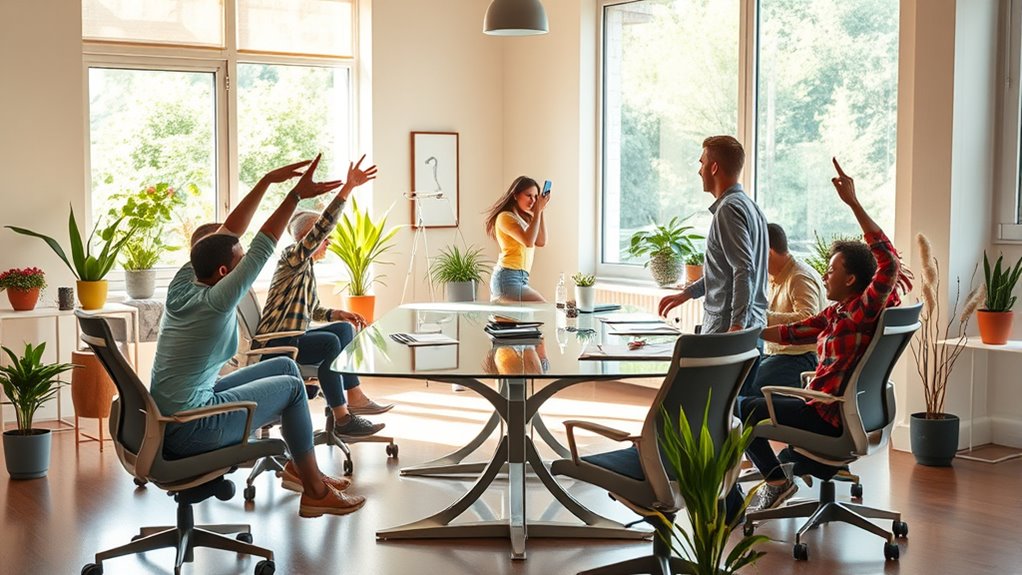
Many creative projects have been revitalized through the power of active rest, proving that stepping away from work can lead to breakthrough ideas. For example, artists and writers often credit mindfulness meditation during breaks for sparking new perspectives. Taking time to pause allows you to clear mental clutter and reconnect with your artistic expression. One designer found that short periods of active rest, like walking or stretching, helped her see problems from fresh angles, resulting in more innovative solutions. These success stories demonstrate that structured breaks aren’t just relaxing—they’re catalysts for creativity. By intentionally engaging in activities like mindfulness meditation or simple movement, you create space for your subconscious to work through challenges and generate inspiration. Grocery Store Hours can influence how you plan your day and optimize your creative time, highlighting the importance of awareness in your routine. Active rest truly transforms how you approach your creative projects.
Tips for Maintaining a Consistent Active Rest Routine
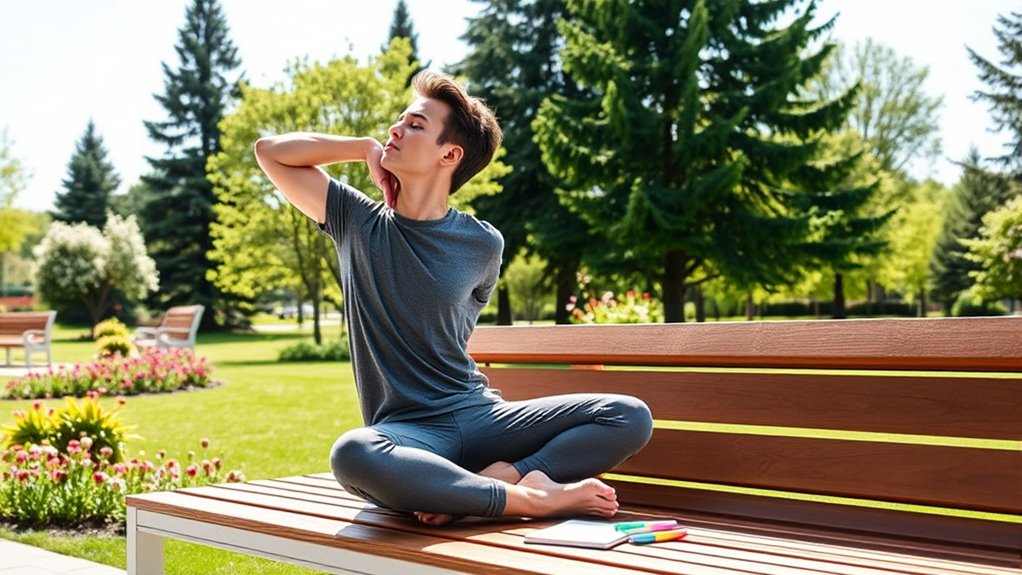
Maintaining a consistent active rest routine requires intentionality and habit formation. To stay on track, try these tips:
- Schedule daily outdoor walks at the same time, making it a non-negotiable part of your day.
- Incorporate mindful stretching into your breaks, focusing on breath and body awareness to enhance relaxation.
- Set reminders or alarms to prompt you to pause and engage in active rest activities.
- Keep your gear ready—comfortable shoes, yoga mats—so you can jump into your routine without delay.
- Use proper equipment, like comfortable shoes and lightweight gear, to ensure your active rest activities are effective and enjoyable.
Frequently Asked Questions
Are There Specific Types of Activities That Work Best for Active Rest?
When considering activities for active rest, you’ll find that creative walking and stretching exercises work best. These activities help you clear your mind and boost your creativity by engaging your body gently. You can walk outdoors, exploring new places or nature, which stimulates ideas. Stretching exercises also keep your muscles relaxed and improve circulation, making it easier to return to your work refreshed and inspired.
How Long Should Each Active Rest Session Ideally Last?
Imagine giving yourself a gentle pause, a moment to reset. When it comes to duration guidelines, aim for active rest sessions lasting around 5 to 10 minutes. This ideal timing helps rejuvenate your mind without breaking your flow. Short, intentional breaks maintain your energy and creativity, so listen to your body and adjust as needed. Remember, quality over quantity makes these breaks truly effective.
Can Active Rest Benefit People With Physical Disabilities?
You might wonder if active rest benefits people with physical disabilities. The answer is yes. Adaptive exercises and inclusive activities can be integrated into your active rest periods, helping you stay engaged and promote recovery. These structured breaks boost creativity and prevent burnout without putting strain on your body. By tailoring activities to your abilities, you ensure active rest is both effective and accessible, supporting your overall well-being and mental refreshment.
Is Active Rest Effective During High-Stress Work Periods?
During high-stress work periods, active rest can be highly effective. By engaging in mindful movement, you give your mind a break while physically recharging. Incorporate passive cooling techniques like deep breathing or gentle stretching to help reduce stress levels. These structured breaks allow you to reset mentally and physically, boosting your focus and productivity when you return to work. Active rest isn’t just a break; it’s a tool for sustained performance.
How Can Employers Encourage Active Rest Among Employees?
You can encourage active rest by integrating wellness programs that promote structured breaks, making it easy for employees to step away from their desks. Foster employee engagement by organizing group activities or movement challenges during work hours. When you support active rest, you help reduce stress and boost creativity, which benefits both your team and the company’s overall productivity. Creating a culture that values these breaks shows you prioritize employee well-being and performance.
Conclusion
By embracing active rest, you plant seeds of inspiration in the fertile soil of your mind. These structured breaks act as gentle rain, nourishing your creativity, while movement becomes the sun that helps ideas blossom. As you nurture this rhythm, your thoughts grow clearer and more vibrant, transforming ordinary moments into a wellspring of innovation. Remember, in the garden of your mind, active rest is the catalyst that helps your brightest ideas flourish.









